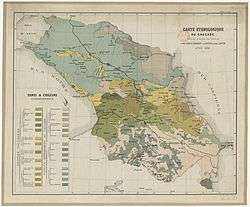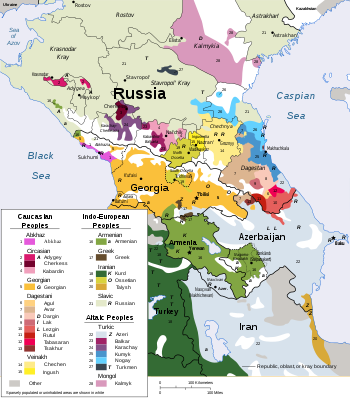Tat language (Caucasus)
The Tat language or Tat/Tati Persian[4][5] or Tati (Tat: zuhun tati) is a Southwestern Iranian language closely related to,[6] but not fully mutually intelligible[7] with Persian and spoken by the Tats in Azerbaijan and Russia. There is also an Iranian language called Judeo-Tat spoken by Jews of Caucasus.
| Tat | |
|---|---|
| zuhun tati | |
| Native to | Azerbaijan, Dagestan (Russia) |
| Region | North Caucasus, Transcaucasia |
Native speakers | (28,000 excluding Judeo-Tat cited 1989 –no date)[1] |
| |
| Language codes | |
| ISO 639-3 | ttt |
| Glottolog | musl1236[3] |
| Linguasphere | 58-AAC-g |
 | |
General information
The Tats are an indigenous Iranian people in the Caucasus[8][9] who trace their origin to the Sassanid-period migrants from Iran (ca. fifth century AD).[10]
Tat is endangered,[11][12] classified as "severely endangered" by UNESCO's Atlas of the World's Languages in Danger.[13] Most scholars divide Tat into two general varieties: Jewish and Muslim, with religious differences correlating with linguistic differences.[14]
Another, almost extinct, variety of Tat is spoken by Christians of Armenian origin, who are called Armeno-Tats.
Dialects
Vladimir Minorsky mentions in the first edition of Encyclopaedia of Islam that like most Persian dialects, Tati is not very regular in its characteristics, and occupies a position between modern Persian and the Caspian dialects.[15] According to him, The Great Russian Encyclopedia of 1901 gives the number of Tati speakers in 1901 as 135,000.[15] In the 1930s, Minorsky estimated the number of Tati speakers to be 90,000 and the decrease to be the result of gradual Turkicization.[15]
Speakers
According to the 1989 Soviet census, 30,000 Tats lived in the Soviet Union, of which 10,000 were in Azerbaijan.[14] Not all likely speak Tati, and this does not include the more rural locations that were not reached by the census. It is vital to stress that the Tats are one of the most assimilated of Azerbaijan’s ethnic groups. This is particularly true for urban Tats. All of this makes it difficult to identify the true number of the Tat ethnic group.[17]
The adults in most of the mountain and foothill communities reported they use Tat as their main language of interaction. They speak Tat with each other, but speak Azerbaijani with their children so that they will learn the language before beginning school. If the wife in the family is non-Tat speaking, however, the family is most likely to use Azerbaijani in the home. In the villages of Lahıc and Zǝyvǝ, women who marry in are reported to learn Tat.[14]
Ethnic population
Research has demonstrated that the word “Tat” does not have an ethnic origin. This is the term the Turks used to denote the settled Iranian-speaking population of Azerbaijan. This is proven by the names some groups of the Tat population have given themselves. For example, the residents of the Apsheron settlements of Balakhany and Surakhany call themselves Pars, and those of the settlement of Lagich in the Ismailly district the Lohudj. It must be mentioned that in the 19th century, cattle herders called the seasonal workers from southern Azerbaijan Tat, although they were ethnic Turks.[17]

Case study: Mǝlhǝm
The town of Mǝlhǝm is largely Tat. Mǝlhǝm lies 6 km north of Şamaxı town on the A12 road. An estimated 1,500 residents live in Mǝlhǝm, a number higher than five years ago. The increase in population is primarily due to an increase in birth rate. According to the mayor, while approximately 10–15% of residents go to Baku to study or work, most return. Ethnically, the village is made up entirely of Tats, with the exception of a handful of ethnic Azerbaijani brides.[14]
Writing system
Tat was not written until 1935. Efforts are being made at preservation. "Since 1996, the Azerbaijani government has provided money for the development of minority languages, including Tat. Haciyev (personal communication) reports that Tat classes have been started in several schools in the Quba region using an alphabet based on the current Azerbaijani Latin alphabet." [14]
Vocabulary
| English | Tat | Zaza | Kurmanji | Mazanderani | Persian |
|---|---|---|---|---|---|
| blood | xun | goni | xwûn, xwîn | xun | xûn |
| bread | nun | nan, non | non | nun | nân |
| brother | birar | bıra | bra, brat | birâr | barâdar |
| dark | tarik, tariki | tari | tarî | târîk | |
| day | ruz | roce, roje, roze | roj | ruz, ruj | ruz |
| donkey | xər | her | ker | xar | xar |
| eye | çüm | çım | çav | çəş | chashm |
| father | piyər | pi, pêr | bav, bab | piyer, per | pedar |
| fire | ataş | adır | agir | taş | âtash |
| God | Xuda | Homa/Huma/Oma, Heq | Xweda, Xudê, Xwedê, Xwādê | Xedâ | Xodâ, Yazdân |
| good | xub, xas, çak | hewl, rınd, weş | baş, rind | xâr, xojir, xeş | xub, beh |
| grass | güyo | vaş | gîya, çêre | vâş | sabzeh, giyah |
| language | zuhun | zıwan, zon | ziman | zivan, zebun | zabân |
Linguistic migration
The prominence of the Tati language is directly related to migration. Additionally, most Tats in Azerbaijan live in the Apsheron zone, as well as the following districts: Khyzy, Divichi and Guba. The Tat people have been dispersed in northeast Azerbaijan. By their origin, the Tats are direct descendants of the Iranian-speaking population that migrated back in the era of the Sassanids to the Caspian coastal regions of Azerbaijan. Most of the Tats in Azerbaijan live in the Apsheron zone and the districts of Khyzy, Divichi, Guba and some others.[17]
Tats and Azerbaijanis
Coexistence between Tats and Azerbaijanis have combined much of the two cultures. Azerbaijani has largely overtaken Tati, which has also sparked a takeover in the ethnic consciousness of the Tats. The Tats and Azerbaijanis have gained much in common both industrially and culturally and in everyday life from their centuries of co-existence. Here a significant role has been played by the Azerbaijani language, which since the 19th century has been virtually the second native tongue for the Tats. The wide use of Azerbaijani, though, has imposed some constraints on the Tat language, which had become the general language in rural areas. Significant changes have taken place in the ethnic consciousness of the Tats. Many of them consider themselves to be Azerbaijani and have largely lost the Tat language.[17]
Linguistic policies in Azerbaijan
Azerbaijan has approached its linguistic policies in an interesting way. These policies include education in Tat. The development of a fundamentally new linguistic policy that reflected the country's ethnic minorities, again, which would have included the Tati people, is described by Latifa Mammadova as the following: "In the early post-Soviet years, Azerbaijan’s authorities faced the challenge of developing a fundamentally new concept of ethnic and linguistic policies, one that would be tactful toward the country’s ethnic minorities and mindful of the sensitivities of each. They started by elaborating a law on the protection of rights and freedoms of the country’s ethnic minorities in the area of culture. This document guaranteed fundamental rights for minority groups and individuals, including the right to receive education and publish press in their mother tongue. It also proclaimed some universal values of multicultural society, such as equality, partnership, tolerance, solidarity, and justice."[18]
References
- Tat at Ethnologue (18th ed., 2015)
- Windfuhr, Gernot. The Iranian Languages. Routledge. 2009. p. 417.
- Hammarström, Harald; Forkel, Robert; Haspelmath, Martin, eds. (2017). "Muslim Tat". Glottolog 3.0. Jena, Germany: Max Planck Institute for the Science of Human History.
- Gernot Windfuhr, "Persian Grammar: history and state of its study", Walter de Gruyter, 1979. pg 4:""Tat- Persian spoken in the East Caucasus""
- Windfuhr, Genot (2013). Iranian Languages. Routledge. p. 417. ISBN 978-1135797041.
The Northwestern outpost of Persian is Caucasian Tat Persian (...)
- Gruenberg, Alexander. (1966). Tatskij jazyk [The Tat language]. In Vinogradov, V. V. (ed.), Jazyki narodov SSSR. Volume 1: Indoevropejskie jazyki, 281-301
- Authier, Gilles (2012). Grammaire juhuri, ou judéo-tat, langue iranienne des Juifs du Caucase de l'est. Wiesbaden: Reichert
- H. Pilkington,"Islam in Post-Soviet Russia", Psychology Press, Nov 27, 2002. p. 27: "Among other indigenous peoples of Iranian origin were the Tats, the Talishes and the Kurds"
- T. M. Masti︠u︡gina, Lev Perepelkin, Vitaliĭ Vi͡a︡cheslavovich Naumkin, "An Ethnic History of Russia: Pre-Revolutionary Times to the Present", Greenwood Publishing Group, 1996 . p. 80:""The Iranian Peoples (Ossetians, Tajiks, Tats, Mountain Judaists)"
- История Ширвана и Дербенда X—XI веков. М. Издательство восточной литературы. 1963 Библиотека Vostlit.info.
- Published in: Encyclopedia of the world’s endangered languages. Edited by Christopher Moseley. London & New York: Routledge, 2007. 211–280.
- Do the Talysh and Tat Languages Have a Future in Azerbaijan? Archived 2011-06-04 at the Wayback Machine
- UNESCO Interactive Atlas of the World’s Languages in Danger
- John M. Clifton, Gabriela Deckinga, Laura Lucht, Calvin Tiessen, “Sociolinguistic Situation of the Tat and Mountain Jews in Azerbaijan,” In Clifton, ed., Studies in Languages of Azerbaijan, vol. 2 (Azerbaijan & St Petersburg, Russia: Academy of Sciences of Azerbaijan & SIL International 2005).
- V. Minorsky, "Tat" in M. Th. Houtsma et al., eds., The Encyclopædia of Islam: A Dictionary of the Geography, Ethnography and Biography of the Muhammadan Peoples, 4 vols. and Suppl., Leiden: Late E.J. Brill and London: Luzac, 1913–38. Excerpt: Like most Persian dialects, Tati is not very regular in its characteristic features"
- http://www.endangeredlanguages.com/lang/ttt
- Aliaga Mamedov, “Aspects of the Contemporary Ethnic Situation in Azerbaijan,” CA & CC Press (Sweden: AB Publishing House).
- Latifa Mammadova, “Azerbaijan: Cultural Synergies and Diversity,” Ministry of Culture and Tourism of the Republic of Azerbaijan (paper presented at Linguistic and Cultural Diversity in Cyberspace: Proceedings of the International Conference at Yakutsk, Russian Federation, 2–4 July 2008, Sponsored by the Commission of the Russian Federation for UNESCO, Russian Committee of the UNESCO Information for All Programme, Interregional Library Cooperation Centre
Further reading
- Donald W. Stilo, “The Tati Language Group in the Sociolinguistic Context of Northwestern Iran an Transcaucasia,” Iranian Studies: Journal of the Society for Iranian Studies (IranS) 14 (1981).
- Gernot L. Windfuhr, “Typological Notes on Pronominal Cases in Iranian Tati,” Bulletin of the Asia Institute 4 (1990).
- Giles Authier, “New Strategies for Relative Clauses in Azeri an Apsheron Tat,” In Clause Linkage in Cross-Linguistic Perspective: Data-Drive Approaches to Cross-Clausal Syntax (Berlin: de Gruyter Mouton 2012).
- John M. Clifton, “Colonialism, Nationalism and Language Vitality in Azerbaijan,” in Responses to Language Endangerment: In honor of Mickey Noonan. New Directions in Language Documentation and Language Revitalization, ed. Elena Mihas, Bernard Perley, Gabriel Rei-Doval, Kathleen Wheatley (Amsterdam: John Benjamins Publishing Company, 2013): 201–205.
- John M. Clifton, “Do the Talysh and Tat Languages Have a Future in Azerbaijan?” SIL International & University of North Dakota.
- A.A. Saegehi, “New Words from the Old Language of Arran, Shirvan an Azerbaijan,” Iranian Journal of Linguistics 17.1 (2002) 21–40.
- Abbas Taheri, “Tati Dialect of Takistan,” Iranian Journal of Linguistics 9.2 (1992) 25–39.
External links
| Tat language (Caucasus) test of Wikipedia at Wikimedia Incubator |
- Language Map of Azerbaijan.
- Endangered Languages Project, Muslim Tat
- Tat Numeral System
- 100-word Swadesh list collected 2013 in Lahıc village
